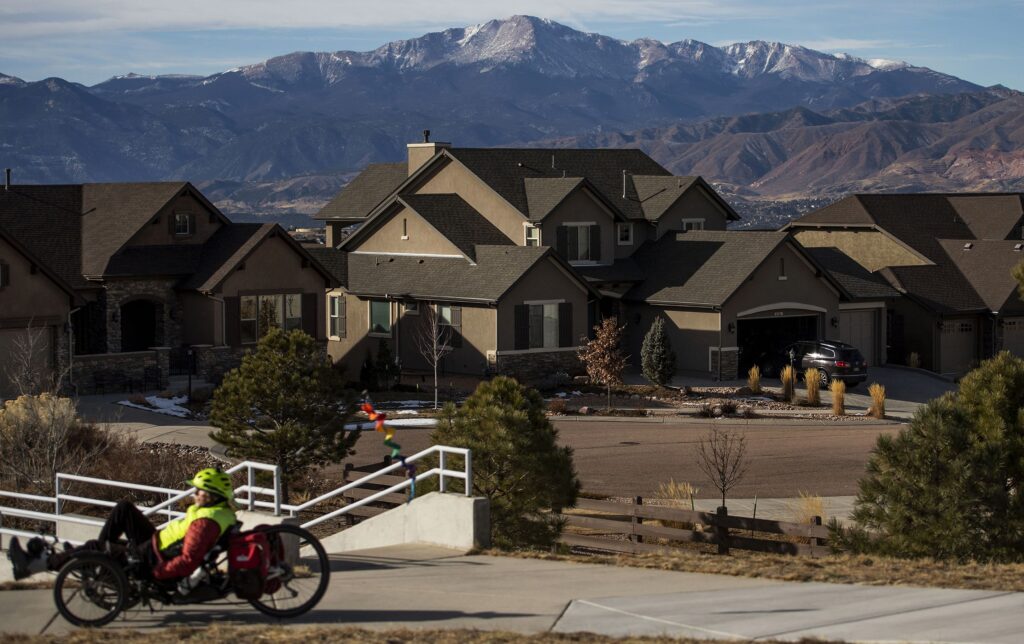‘We’re going to have to make some concessions:’ City, county panelists address growth, affordable housing

In the Colorado Springs area, the need for affordable housing – and fears that growth is not being managed responsibly – is at an all-time high, some economic and development experts believe.
During a town hall meeting hosted by The Gazette and KOAA on Thursday, panelists from several city and El Paso County departments, Colorado Springs Utilities, the Colorado Springs Chamber & Economic Development Corp. and more weighed in on the topics of water availability, public safety and the job market and addressed discrepancies between what officials and the public may see as “good growth.”
5 growth hotspots around Colorado Springs: A closer look
The Springs has gained almost 109,000 people over the past 20 years, reaching a population of just over 485,000 at the halfway point of last year, according to the most recent estimate available from the Colorado Demography Office, which tracks population and other demographic trends.
El Paso County’s population has grown from about 500,000 to 755,000 since 2000 – a 43% increase – and about 10,500 people are moving to the county each year, according to Tatiana Bailey, executive director of Data Driven Economic Strategies.
“Most of the growth that’s happening in the state of Colorado, percentage wise, is here in El Paso County,” Bailey said.
Affordable housing
Those surges have made the issue of affordable housing one of the top hot-button topics in recent years and Thursday.
Bailey said that kind of demand warrants a need for roughly 8,500 new permits for multifamily and single-family units per year, but could fall about 14,000 units short by 2028, accounting for projected growth.
Just before the COVID-19 pandemic struck in early 2020, the percentage of homes sold in the county that were affordable – costing less than 30% of one’s household income – was just under 75%, Bailey said.
That number is now 25%, up from 18% at the worst quarter of the pandemic, she said.
According to city chief housing officer Steve Posey, the lack of affordable housing is affecting people across generational and socioeconomic groups.
“This is no longer an issue that is just touching lower income households, “Posey said. “This is an issue that is of concern for everybody in Colorado Springs and El Paso County.”
The region’s average age is trending younger, around 35, and younger people tend to average lower salaries. More and more high school and college graduates are staying in their parents’ homes, leaving both groups “stuck” with few options, he said.
Posey said even many of those moving to the region for professional work, like X-ray technicians and other health care workers, for example, qualify for the kind of housing authorized under Proposition 123, an initiative passed in November that will direct $300 million per year in TABOR refund revenues into affordable housing programs statewide.
Residents over age 65, the county’s second-largest demographic and many of whom live on fixed income, have also seen home, apartment and senior living rent prices skyrocket, Posey said.
Even so, residents have repeatedly voiced in many a city and county planning commission hearing, online discussion platform and question submitted to the panelists that water use and growth – especially of apartment buildings and massive subdivisions on the urban fringe – has gone too unchecked for too long.
Got growth? Colorado Springs residents, developers debate as decades-long trends continue
“I am concerned with the number of multifamily apartment buildings currently in our city in addition to the number of new units being built,” one resident wrote. “Why is there such emphasis on this type of housing and high rent costs versus encouraging residents to invest in property and more permanent housing?”
“Why is our housing so low?” another asked.
Meggan Herington, director of planning and community development for the county, said that while nearly everyone recognizes the need for affordable housing, many residents have voiced opposition to the building methods – mixed and high-density land use – experts say are needed to address the issue.
“What we typically hear from citizens is … that (new development) is ‘too dense, there’s not enough transition, we don’t have enough buffers,'” Herington said. “I ask the question back to the citizens, what does smart growth mean to you?”
Herington said any perception that swaths of project requests brought before the county are rubber stamped is mostly false.
In 2023 so far, her department has received over 400 major development applications, such as for rezoning or subdivision plats, she said. Of the 500 “early assistance meetings” held so far with applicants before submitting plans, only 40 of those were about rezoning, just half of those went forward and even less were approved.
“If you ask me if we have a growth problem, I would say no,” Herington said. “I would say that we are doing something right because people want to come and live here.”
Bailey said the things that are “working right” are not as “sensationalized” as what’s not.
“We do have to compromise and think about what type of growth do we do we want and how can we embrace it?” she said. “We’re going to have to make some concessions.”
Water
In the arid west, residents and officials agree that development and water discussions go hand in hand.
Lisa Barbato, chief officer of system planning and projects for Colorado Springs Utilities, said its supply of roughly 95,000 acre-feet of water exceeds its customers’ current demand of 73,000 acre-feet and is being mitigated through the service’s “sustainable water plan,” a 50-year “roadmap” for meeting future needs.
That comprehensive plan involves adding water supplies, replacing invasive grass species and using other conservation techniques and mitigating fire danger around watersheds, she said.
“We are using the same amount of water we used 40 years ago with our population on nearly doubling,” Barbato said. “Our community has really responded in a responsible way, and that is really allowing us that buffer to grow within our community.”
The Colorado Springs City Council in January approved a controversial water ordinance that requires CSU to have 128% of the water necessary to serve existing city demand and the projected demand from new properties, a move that benefits existing developers within the city and could block large annexations planning to build new neighborhoods.
Posey, the city housing officer, encouraged residents to continue to participate in planning hearings regarding new developments, but said many applications that do make it that far have done the work to adhere to master growth plans.
“We should be able to rely on the folks who have done the hard work of figuring out whether or not we’ve got that supply available,” he said. “I hope that we don’t need to revisit it every time we get a new subdivision plat … or a new apartment building that comes up.”








